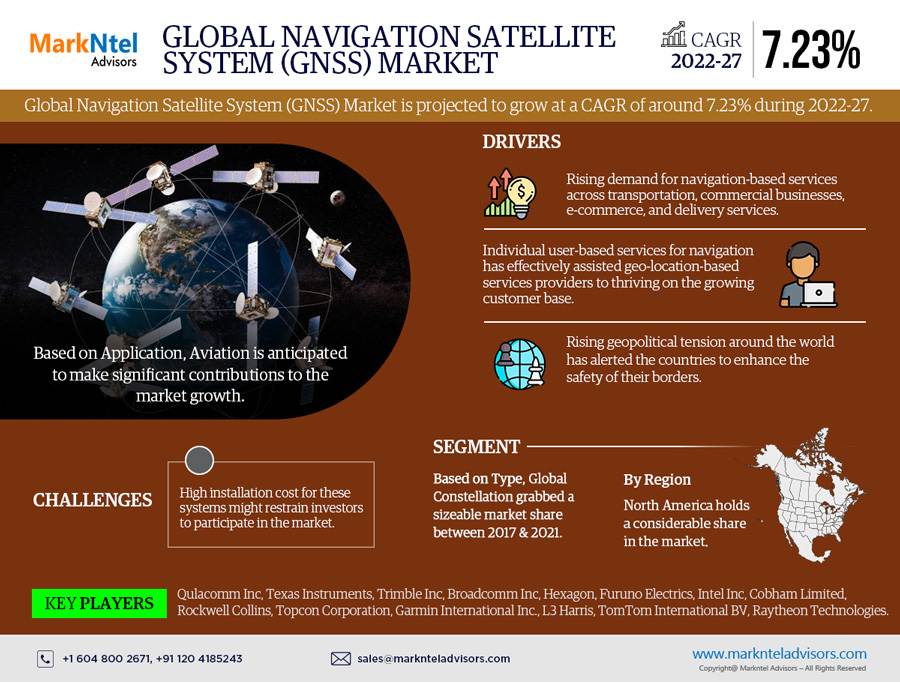
Global Navigation Satellite System Market Research Report: Forecast (2022-27)
By Type (Global Constellation, Regional Constellations, Satellite-based Augmentation), By Application (Rail, Aviation, Maritime, Surveying, Time Synch, Agriculture, Location-Based ...Service (LBS), Road, Military), By Region (North America, South America, Europe, the Middle East & Africa, Asia-Pacific), By Competitors (Qualcomm Inc., Texas Instruments, Trimble Inc., Broadcomm Inc., Hexagon, Furuno Electrics, Intel Inc., Cobham Limited, Rockwell Collins, Topcon Corporation, Garmin International Inc., L3 Harris, TomTom International BV, Raytheon Technologies) Read more
- Aerospace & Defense
- Jul 2022
- Pages 185
- Report Format: PDF, Excel, PPT
Market Definition
The Global Navigation Satellite System (GNSS) is a constellation of several satellites that provide signals from space to supply transmit, positioning, and timing-related data to the GNSS receiver, which further helps to determine the location. The demand for applications using location-based services has extensively grown with the increasing use of smartphones, digital cameras, tablets, smart wearables, etc. Moreover, the increasing air travel across the globe has led to an increased focus on air fleet adoption by commercial aviation companies.
Furthermore, the rising geopolitical tensions leading to increased military spending & higher adoption of military jets by the leading militaries such as the US, Russia, China, India, France, etc. have led to accelerating the demand for the Navigation Satellite System (GNNS) installed in them for navigating their routes. Hence, enhancing the demand for the Navigation Satellite System (GNSS) in the market in the coming years.
Market Insights
The Global Navigation Satellite System (GNSS) Market is projected to grow at a CAGR of around 7.23% during the forecast period, 2022-27. The market has witnessed significant growth in the historical period of 2017-2021. With the rising demand for navigation-based services across various industries such as transportation, commercial businesses, e-commerce, delivery services, etc., the demand for navigation-enabled systems has grown in the respective period. The rise in the online sales of goods has contributed enormously to navigation-based systems with the growing need for real-time tracking of goods to ensure smooth deliveries.
Another factor that has proven to be conducive to the growth of the navigation satellite systems market is the surge in the smartphone user population across the globe. This has ensured the growth in the individual user-based services for navigation purposes & has effectively assisted various geo-location-based services providers in thriving on the growing customer base.
| Report Coverage | Details |
|---|---|
| Study Period | Historical Data: 2017-20 |
| Base Year: 2021 | |
| Forecast Period: 2022-27 | |
| CAGR(2022-27) | 7.23% |
| Regions Covered | North America: The US, Canada, Mexico |
| Europe: Germany, The UK, France, Italy, Spain, Russia | |
| Asia-Pacific:China, India, Japan, South Korea, Rest of Asia-Pacific | |
| South America: Brazil, Rest of South America | |
| Middle East & Africa: Israel, UAE, Saudi Arabia, South Africa | |
| Key Companies Profiled |
Qulacomm Inc, Texas Instruments, Trimble Inc, Broadcomm Inc, Hexagon, Furuno Electrics, Intel Inc, Cobham Limited, Rockwell Collins, Topcon Corporation, Garmin International Inc., L3 Harris, TomTom International BV, Raytheon Technologies, Others |
| Unit Denominations | USD Million/Billion |
Furthermore, the rising geopolitical tension around the world has alerted the countries to enhance the safety of their borders. Thus, increasing government initiatives to manufacture their own Navigation Satellite System is leading the demand in the market. Some of the GNNS are GPS of the US, GLONASS of Russia, Navigation Indian Constellation (NavIC) of India, QZSS of Japan, Beidou of China, etc.
Key Trend in the Market:
- AI-based Navigation Satellite System is Accelerating the Market Growth
Navigation services have become an essential part of the day-to-day operations of the businesses as well as have increasingly made customers reliant on navigation for the route & rerouting in transportation. With the addition of AI in navigation-based services, the companies could easily reduce the errors made in the earlier experience as well as improve the overall customer experience. For military purposes, navigation services are being used for targeting & mapping the path of aircraft, projectiles, etc. Moreover, with the mobile targets, the requirement for AI to be integrated into the navigation satellite systems to provide an optimum solution for rerouting in different terrains would be highly efficient for increasing the effectiveness.
Additionally, many of the Inertial navigation systems providers have effectively integrated AI into the existing solutions for the military to increase the efficiency of targeting as well as developing similar systems to be integrated into the Unmanned Aerial Vehicles (UAVs).
Impact of COVID-19 on the Global Navigation Satellite System (GNSS) Market
COVID-19 disrupted the supply chain & led to the shortage of raw materials for various products leading to reduced manufacturing of electronic products in various industries, including the automobile, mobile manufacturing companies, etc., affecting the sectors adversely. However, the demand for the Global Navigation Satellite System (GNSS) accelerated during the period, owing to the shift of customers towards online shopping & the boost of the e-commerce sector.
Along with this, the inclination toward the online transaction also boosted the demand for the GPS during the transaction. Hence, these factors helped the Navigation Satellite System (GNNS) to gain traction during the period & further are also anticipated to grow in the coming years.

Market Segmentation
Based on the Type:
- Global Constellation
- Regional Constellations
- Satellite-based Augmentation
Here, Global Constellation grabbed a sizeable market in the Global Navigation Satellite System (GNSS)s market between 2017 & 2021. With the availability of global satellite constellations such as Global Positioning Systems (GPS), a large number of devices have been configured with it in order to access navigation services across the globe. Hence, due to the adoption of GPS-enabled services the Global Constellation has gained a major market share in the global GNSS market.
Further, GPS-enabled systems have been extensively used for navigation by the individual user, as well as by commercial businesses & government agencies for geo-location purposes. As global constellation systems provide global navigation services, phone manufacturers, and other communication device manufacturers opt to use them to attract a broader audience. This has attracted a large number of companies involved in device manufacturing to integrate GPS-compatible tracking devices & systems, leading to the segment finding extensive growth globally.
Based on Application:
- Rail
- Aviation
- Maritime
- Surveying
- Time Synch
- Agriculture
- Location-based Service (LBS)
- Road
- Military
- Others
Of them all, Aviation is one of the prominent segments with the requirement of satellite-based navigation to ensure path correction as well as real-time tracking of the location. With the extensive fleet of commercial jets used in transportation & rise in individual commercial jets ownership, the ground infrastructure for aviation has expanded throughout the globe. Furthermore, with the extensive integration of new jets of the 4th & 5th generation by the military sector, the demand for satellite navigation-based services for course correction, payload delivery, and real-time tracking of the path would further escalate in the forthcoming years.
Consequently, there has been a rise in the investment in navigation devices to be integrated with existing architectures to ensure the positioning of aircraft for operational activities and to ensure safety measures.
Regional Landscape
Geographically, the Global Navigation Satellite System (GNSS) Market expands across:
- North America
- South America
- Europe
- The Middle East & Africa
- Asia-Pacific
Of all the regions around the world, North America holds a considerable share in the Global Navigation Satellite System (GNSS) market due to its Global Positioning System (GPS), owned by the US, which is used worldwide for determining location, navigation, tracking, mapping, and timing. The railway is one of the prominent users of navigation services in North America. For instance, the presence of Positive Train Control system (PTC), a family of automatic train protection systems in the US, uses GPS-based safety technology to stop & prevent collisions of the train.
Further, it also limits other unauthorized train movements that ensure the safety of the passengers & drivers. Hence, the presence & increased use of such a system has helped the region lead the market growth.
Recent Developments by Leading Companies
- In 2022, Qualcomm Technologies & Trimble TRMB announced the launch of the new technology of Trimble RTX GNSS for Snapdragon 8 Gen 1 & Snapdragon 888 Mobile Platforms. This technology allows superior location capabilities in these Android smartphones worldwide. It aimed to provide higher quality & accurate location-based user experience in-car navigation with lane-level guidance.
Market Dynamics:
Key Driver: Rise in E-commerce Services to Lead the Demand for Navigation Satellite Systems
The global e-commerce industry has gone through rapid growth & has numerous requirements for location-based services, which include tracking orders for delivery in real time and providing information to customers in order to maintain customer satisfaction and avoid delays, which are some of the major reasons for increased demand for satellite navigation systems. Further, the advent of navigation services for individual customers has also enabled the growth of the individual business to operate through online channels & effectively deliver goods to distant locations.
In response to this phenomenon, many communication device manufacturers are integrating navigation-based equipment for accessing navigation constellations such as BeiDou, GLONASS, GPS, QZSS, IRNSS, etc., to cater to a wider audience & build a robust eco-system to ensure navigation services work effectively across different geographies without disruption.
Possible Restraint: High Cost of R&D to Restrict the Companies to Enter the Satellite Navigation Systems Market
GNSS signals are delivered to end-users with various other components, such as antennas, receivers, software, advanced network stations, etc. Hence, the investment required in the initial installation of the system is high. The initial investment is required for Research & Development (R&D) as well as establishing manufacturing units with technological know-how is a challenging task for the majority of companies with little to no technical expertise. Due to this, many companies have decided not to enter the Satellite Navigation Systems industry, resulting in the market's expansion being limited. Therefore, the high initial cost of R&D would be a challenging factor for the market growth of the Navigation Satellite System (GNSS).
Key Questions Answered in the Market Research Report:
- What are the overall statistics or estimates (Overview, Size- By Value, Forecast Numbers, Segmentation, Shares) of the Global Navigation Satellite System (GNSS) Market?
- What are the region-wise industry size, growth drivers, and challenges?
- What are the key innovations, opportunities, current & future trends, and regulations in the Global Navigation Satellite System (GNSS) Market?
- Who are the key competitors, their key strengths & weaknesses, and how do they perform in the Global Navigation Satellite System (GNSS) Market based on the competitive benchmarking matrix?
- What are the key results derived from surveys conducted during the Global Navigation Satellite System (GNSS) Market study?
Frequently Asked Questions
- Introduction
- Product Definition
- Research Process
- Assumptions
- Market Segmentation
- Preface
- Executive Summary
- Impact of COVID-19 on Global Navigation Satellite System (GNSS) Market
- Global Navigation Satellite Systems Market Key Statistics:
- Growth in Number of Navigation Satellites, By Country/Regions, Year 2017-2022E
- Growth in the Number of Global Smartphone Users, Year 2017-2022E
- Government Initiatives & Policies for Global Navigation Satellite Systems Market, 2017-2021
- Funding Received by the Start-ups in Global Navigation Satellite Systems Market
- Impact of Artificial Intelligence (AI) on the Navigation Satellite System (GNSS) Market
- Global Navigation Satellite System (GNSS) Market Government Regulations and Policies
- Global Navigation Satellite System (GNSS) Market Trends & Insights
- Global Navigation Satellite System (GNSS) Market Dynamics
- Growth Drivers
- Challenges
- Impact Analysis
- Global Navigation Satellite System (GNSS) Market Hotspot & Opportunities
- Global Navigation Satellite System (GNSS) Market Outlook, 2017-2027F
- Market Size & Analysis
- Market Revenues
- Market Share & Analysis
- By Type
- Global Constellation
- Regional Constellations
- Satellite-Based Augmentation
- By Application
- Rail
- Aviation
- Maritime
- Surveying
- Time Synch
- Agriculture
- Location-Based Service (LBS)
- Road
- Military
- Others
- By Region
- North America
- South America
- Europe
- Middle East & Africa
- Asia-Pacific
- By Competitors
- Competition Characteristics
- Market Share & Analysis
- By Type
- Market Size & Analysis
- North America Navigation Satellite System (GNSS) Market Outlook, 2017-2027F
- Market Size & Analysis
- Market Revenues
- Market Share & Analysis
- By Type
- By Application
- By Country
- The US
- Canada
- Mexico
- The US Navigation Satellite System (GNSS) Market Outlook, 2017-2027F
- Market Size & Analysis
- Market Revenues
- Market Share & Analysis
- By Type
- By Application
- Market Size & Analysis
- Canada Navigation Satellite System (GNSS) Market Outlook, 2017-2027F
- Market Size & Analysis
- Market Revenues
- Market Share & Analysis
- By Type
- By Application
- Market Size & Analysis
- Mexico Navigation Satellite System (GNSS) Market Outlook, 2017-2027F
- Market Size & Analysis
- Market Revenues
- Market Share & Analysis
- By Type
- By Application
- Market Size & Analysis
- Market Size & Analysis
- South America Navigation Satellite System (GNSS) Market Outlook, 2017-2027F
- Market Size & Analysis
- Market Revenues
- Market Share & Analysis
- By Type
- By Application
- By Country
- Brazil
- Rest of South America
- Brazil Navigation Satellite System (GNSS) Market Outlook, 2017-2027F
- Market Size & Analysis
- Market Revenues
- Market Share & Analysis
- By Type
- By Application
- Market Size & Analysis
- Market Size & Analysis
- Europe Navigation Satellite System (GNSS) Market Outlook, 2017-2027F
- Market Size & Analysis
- Market Revenues
- Market Share & Analysis
- By Type
- By Application
- By Country
- Germany
- The UK
- France
- Italy
- Spain
- Russia
- Others
- Germany Navigation Satellite System (GNSS) Market Outlook, 2017-2027F
- Market Size & Analysis
- Market Revenues
- Market Share & Analysis
- By Type
- By Application
- Market Size & Analysis
- The UK Navigation Satellite System (GNSS) Market Outlook, 2017-2027F
- Market Size & Analysis
- Market Revenues
- Market Share & Analysis
- By Type
- By Application
- Market Size & Analysis
- France Navigation Satellite System (GNSS) Market Outlook, 2017-2027F
- Market Size & Analysis
- Market Revenues
- Market Share & Analysis
- By Type
- By Application
- Market Size & Analysis
- Italy Navigation Satellite System (GNSS) Market Outlook, 2017-2027F
- Market Size & Analysis
- Market Revenues
- Market Share & Analysis
- By Type
- By Application
- Market Size & Analysis
- Spain Navigation Satellite System (GNSS) Market Outlook, 2017-2027F
- Market Size & Analysis
- Market Revenues
- Market Share & Analysis
- By Type
- By Application
- Market Size & Analysis
- Russia Navigation Satellite System (GNSS) Market Outlook, 2017-2027F
- Market Size & Analysis
- Market Revenues
- Market Share & Analysis
- By Type
- By Application
- Market Size & Analysis
- Market Size & Analysis
- Middle East & Africa Navigation Satellite System (GNSS) Market Outlook, 2017-2027F
- Market Size & Analysis
- Market Revenues
- Market Share & Analysis
- By Type
- By Application
- By Country
- Israel
- UAE
- Saudi Arabia
- South Africa
- Others
- Israel Navigation Satellite System (GNSS) Market Outlook, 2017-2027F
- Market Size & Analysis
- Market Revenues
- Market Share & Analysis
- By Type
- By Application
- Market Size & Analysis
- UAE Navigation Satellite System (GNSS) Market Outlook, 2017-2027F
- Market Size & Analysis
- Market Revenues
- Market Share & Analysis
- By Type
- By Application
- Market Size & Analysis
- Saudi Arabia Navigation Satellite System (GNSS) Market Outlook, 2017-2027F
- Market Size & Analysis
- Market Revenues
- Market Share & Analysis
- By Type
- By Application
- Market Size & Analysis
- South Africa Navigation Satellite System (GNSS) Market Outlook, 2017-2027F
- Market Size & Analysis
- Market Revenues
- Market Share & Analysis
- By Type
- By Application
- Market Size & Analysis
- Market Size & Analysis
- Asia-Pacific Navigation Satellite System (GNSS) Market Outlook, 2017-2027F
- Market Size & Analysis
- Market Revenues
- Market Share & Analysis
- By Type
- By Application
- By Country
- China
- India
- Japan
- South Korea
- Rest of Asia-Pacific
- China Navigation Satellite System (GNSS) Market Outlook, 2017-2027F
- Market Size & Analysis
- Market Revenues
- Market Share & Analysis
- By Type
- By Application
- Market Size & Analysis
- India Navigation Satellite System (GNSS) Market Outlook, 2017-2027F
- Market Size & Analysis
- Market Revenues
- Market Share & Analysis
- By Type
- By Application
- Market Size & Analysis
- Japan Navigation Satellite System (GNSS) Market Outlook, 2017-2027F
- Market Size & Analysis
- Market Revenues
- Market Share & Analysis
- By Type
- By Application
- Market Size & Analysis
- South Korea Navigation Satellite System (GNSS) Market Outlook, 2017-2027F
- Market Size & Analysis
- Market Revenues
- Market Share & Analysis
- By Type
- By Application
- Market Size & Analysis
- Market Size & Analysis
- Global Navigation Satellite System (GNSS) Market Key Strategic Imperatives for Success & Growth
- Competition Outlook (Whichever Applicable)
- Competition Matrix
- Target Markets
- Research & Development
- Collaborations & Strategic Alliances
- Key Business Expansion Initiatives
- Business Restructuring- Mergers, Acquisitions, JVs
- Strategic Initiatives
- Company Profiles (Business Description, Product Segments, Business Segments, Financials, Strategic Alliances/ Partnerships, Future Plans)
- Qulacomm Inc.
- Texas Instruments
- Trimble Inc.
- Broadcomm Inc.
- Hexagon
- Furuno Electrics
- Intel Inc.
- Cobham Limited
- Rockwell Collins
- Topcon Corporation
- Garmin International Inc.
- L3 Harris
- TomTom International BV
- Raytheon Technologies
- Others
- Competition Matrix
21.Disclaimer
MarkNtel Advisors follows a robust and iterative research methodology designed to ensure maximum accuracy and minimize deviation in market estimates and forecasts. Our approach combines both bottom-up and top-down techniques to effectively segment and quantify various aspects of the market. A consistent feature across all our research reports is data triangulation, which examines the market from three distinct perspectives to validate findings. Key components of our research process include:
1. Scope & Research Design At the outset, MarkNtel Advisors define the research objectives and formulate pertinent questions. This phase involves determining the type of research—qualitative or quantitative—and designing a methodology that outlines data collection methods, target demographics, and analytical tools. They also establish timelines and budgets to ensure the research aligns with client goals.
2. Sample Selection and Data Collection In this stage, the firm identifies the target audience and determines the appropriate sample size to ensure representativeness. They employ various sampling methods, such as random or stratified sampling, based on the research objectives. Data collection is carried out using tools like surveys, interviews, and observations, ensuring the gathered data is reliable and relevant.
3. Data Analysis and Validation Once data is collected, MarkNtel Advisors undertake a rigorous analysis process. This includes cleaning the data to remove inconsistencies, employing statistical software for quantitative analysis, and thematic analysis for qualitative data. Validation steps are taken to ensure the accuracy and reliability of the findings, minimizing biases and errors.

4. Data Forecast and FinalizationThe final phase involves forecasting future market trends based on the analyzed data. MarkNtel Advisors utilize predictive modeling and time series analysis to anticipate market behaviors. The insights are then compiled into comprehensive reports, featuring visual aids like charts and graphs, and include strategic recommendations to inform client decision-making









